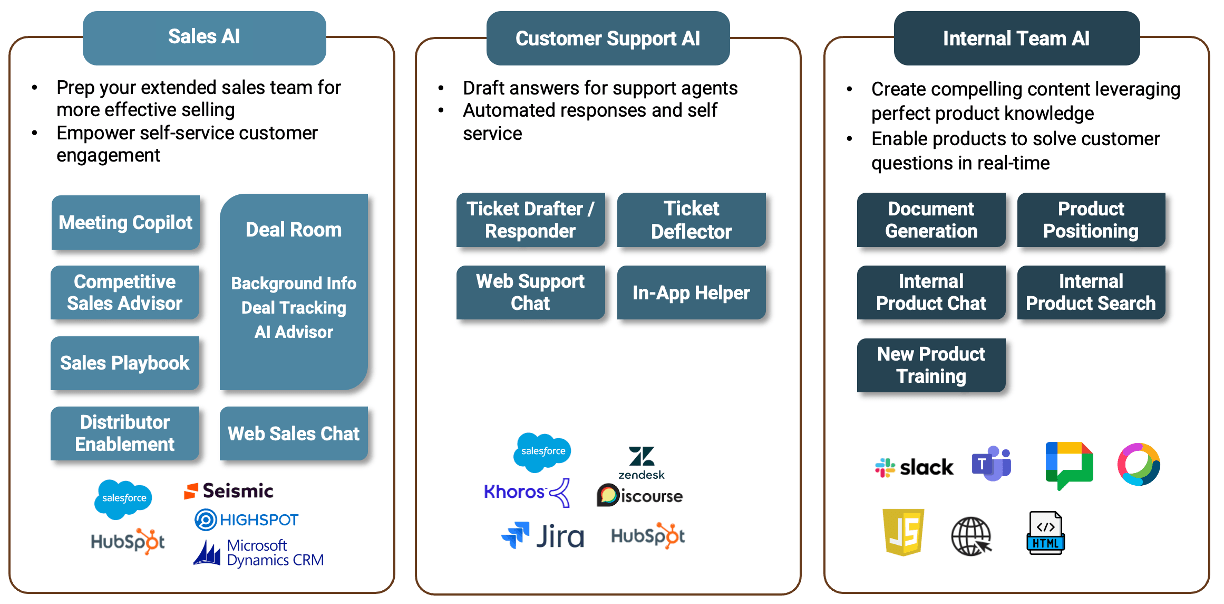3. Requirements: What Enterprises Need to Get Right
AI isn't just a new tool—it's a new way of working. But realizing its full potential depends on how you approach it. B2B enterprises need to move quickly, learn safely, and scale intelligently across functions—without compromising trust, governance, or performance.
The right approach balances speed and control. It enables teams to ship real use cases in days or weeks, then improve through iteration. It prioritizes workflow fit, shared learning across departments, and data ownership, while avoiding the costs and risks of retraining models or managing fragmented tools.
Based on our work with multi-billion-dollar enterprises, successful AI deployments consistently address these five fundamental requirements:
3.1 Deep Product Knowledge: AI That Speaks Your Language
Generic AI fails in product-centric organizations because it lacks the specificity and context needed to support complex workflows. Enterprises must prioritize systems that:
- Speak fluently about their products, SKUs, lifecycle, and support history
- Understand the difference between how a sales engineer and a support agent asks a question
- Adapt to existing tools—CRM, ticketing, team chat—without requiring teams to switch context
Without deep product knowledge, AI simply becomes another unused tool. With it, AI becomes a seamless, expert assistant embedded in the business. Studies show that generic AI chatbots fail to resolve roughly 70% of technical inquiries because they lack deep knowledge of the company's specific products.
During a recent meeting with a major semiconductor manufacturer, their team highlighted the challenge of supporting a 'long tail' market through distributors. They have tens of thousands of product documents, community forums dating back decades, GitHub repositories, and complex technical specifications that require deep understanding. Generic AI tools cannot navigate this complexity effectively.
AI platforms that use retrieval-augmented generation (RAG) to access your product data securely at query time, avoiding the need to train models on your proprietary information.
AI's greatest value comes when insights from one part of the business inform the others. Yet many organizations run isolated pilots—one in support, one in sales, another for internal training—with no shared infrastructure or learnings.
A unified approach allows teams to:
- Reuse knowledge sources across domains
- Share usage patterns, feedback, and improvements
- Improve performance systemwide with every interaction
A shared foundation—spanning knowledge sources, security rules, and feedback loops—enables faster time-to-value and more consistent performance. Fragmentation slows everything down.
The same semiconductor company identified three critical use cases: (1) internal chatbots for navigating complex applications and product portfolios, (2) technical support for long-tail customers who purchase through distribution, and (3) product discovery tools to help customers choose between similar products. A unified platform addresses all three without requiring separate implementations.
A support AI surfacing FAQs can help sales teams better understand customer pain points. Internal AI chatbots that learn from product docs and customer tickets can accelerate onboarding across teams.
The most successful AI deployments fit seamlessly into existing workflows rather than forcing teams to adopt new tools. This means:
- Native connectors for CRM, ticketing, team chat, and knowledge systems
- APIs that plug into existing dashboards and reporting tools
- Single sign-on and role-based access that respects current security models
Integration friction kills adoption. When AI requires teams to switch contexts or learn new interfaces, usage drops dramatically. The goal is to make AI feel like a natural extension of tools teams already use.
The semiconductor company already has existing enterprise platforms for sales (Salesforce), support (Jira Service Management), and distributor platforms(homegrown web portal). They need solutions that integrate with their existing tools rather than replacing them.
Pre-built connectors for Salesforce, Zendesk, Slack, Teams, SharePoint, and other enterprise staples, plus robust APIs for custom integrations.
3.4 Visibility & Control: Trust Through Transparency
No AI deployment will reach scale if teams can't see what's happening and control the outcomes. This requires:
- Real-time dashboards showing answer quality, usage patterns, and performance metrics
- AI Performance Management tools that grade every response and flag potential issues
- Configurable confidence thresholds and human-in-the-loop workflows
- Audit trails for compliance and governance requirements
Without visibility, teams can't trust the AI. Without control, they can't manage risk. Both are essential for enterprise adoption.
The semiconductor company's technical support chatbot needs to handle everything from basic datasheet lookups to advanced debugging and code generation. They require confidence scoring, conflict detection (when different documents contradict each other), and the ability to identify knowledge gaps. They also need guardrails for policy questions (like pricing) and technical constraints.
Platforms that provide continuous monitoring of AI performance, with the ability to adjust confidence thresholds, route low-confidence queries to humans, and maintain detailed logs for compliance.
3.5 Enterprise Security: Built for Scale and Compliance
Enterprise AI must meet the same security standards as any other enterprise software, with additional considerations for AI-specific risks:
- SOC 2 Type II and GDPR support from day one
- Tenant isolation across all architecture layers
- Role-based access control (RBAC) with audit logs and data classification
- Zero data retention options and on-prem deployment paths for sensitive industries
- Encryption at rest and in transit, with key management controls
Security isn't just a checklist -- it's a foundation for adoption. Without it, trust erodes and projects stall. Procurement and IT teams require provable controls before approving any AI deployment.
The semiconductor company has a rep portal that generates confidential, watermarked documents for customers with NDAs. They need AI solutions that can handle sensitive information while maintaining proper access controls and audit trails.
Platforms that offer multiple deployment models (SaaS, dedicated VPC, full on-prem), with clear compliance documentation and security architecture details.
4. Additional Success Factors
Define Clear, Measurable Goals That Enable Fast, Safe Learning
Enterprises often delay AI adoption by waiting for perfect alignment or a single killer app. In reality, the most successful deployments begin with modest, clearly scoped goals that enable teams to learn and iterate quickly.
Examples include:
- Cut ticket response time by 25% for a specific product line
- Deflect 30% of common support inquiries from the website
- Improve sales call prep efficiency by 40% in one territory
- Reduce time-to-first-response on internal product questions by half
These goals should be easy to measure, tied to a real workflow, and achievable in 30–90 days. The priority is not to get it all right on day one—it's to start learning now, and do so safely and visibly.
Control Your Data -- Don't Train Models on It
One of the most important architectural decisions is how AI handles your proprietary information. Too many platforms offer fine-tuning or model training as a path to accuracy—but this often introduces data leakage, compliance risk, and long iteration cycles.
Instead, enterprises should choose platforms that:
- Use retrieval-based generation (RAG) to access data securely at query time
- Avoid training or storing your data in third-party models
- Let you retain full control over what's ingested, indexed, and surfaced
- Offer clear, auditable isolation between tenants, regions, and user roles
This approach enables learning and improvement without giving up control—and keeps data governance aligned with internal policies and external regulations.
Address Real-World Enterprise Challenges
Based on direct customer feedback, enterprises face several specific challenges that AI solutions must address:
Customers increasingly need help choosing between similar products (e.g., 'Should I use BMI 330 or BMI 270 for my application?'). Sales reps and distributors often lack the expertise to answer these questions effectively.
Support needs range from basic datasheet lookups to advanced debugging, code generation, and troubleshooting. The AI must handle the full spectrum while maintaining accuracy and providing appropriate escalation paths.
Large enterprises accumulate massive amounts of technical documentation, community discussions, GitHub repositories, and internal knowledge bases. The AI must ingest, organize, and surface this information intelligently.
AI must distinguish between factual questions and policy questions, applying appropriate business rules (e.g., pricing policies, technical constraints, safety guidelines).
5. Summary: Requirements That Predict Success
| Requirement Area |
What to Get Right |
| Deep Product Knowledge |
AI that understands your catalog, specs, and support context |
| Cross-Use Case Leverage |
Unified platform that supports learning across departments |
| Existing Tool Integration |
Fit AI into existing workflows and tools, not the other way around |
| Visibility & Control |
Real-time monitoring and configurable AI Performance Management |
| Enterprise Security |
SOC 2, GDPR, RBAC, audit trails, and tenant isolation from day one |
| Strategy |
Start with narrow, measurable goals that encourage fast, safe learning |
| Data Ownership |
Retain full control of your data—do not train models on it |
| Real-World Challenges |
Address product discovery, technical complexity, and policy compliance |
Companies that deploy unified, product-aware AI—and do so with control, speed, and security—learn faster, perform better, and scale more confidently than those who wait. The key is choosing a platform that addresses all five critical requirements while enabling rapid iteration and measurable ROI.
Remember: The goal is not to replace your existing tools or processes, but to enhance them with AI capabilities that make your teams more effective. As one enterprise customer put it: "We don't want to rip and replace our CRM, ticketing system, or internal tools. We want AI where our team works."

